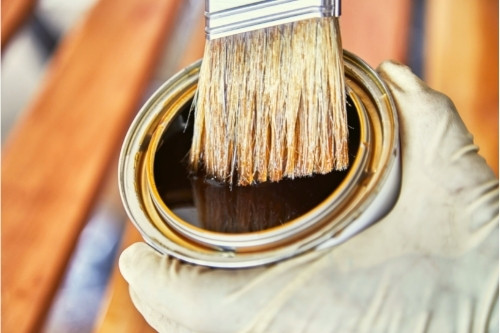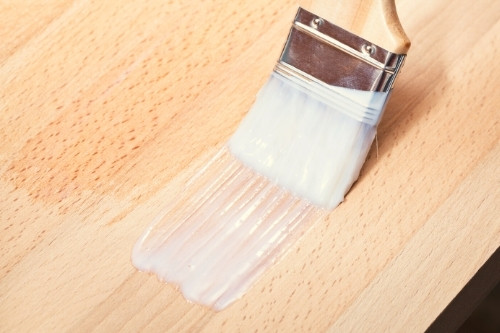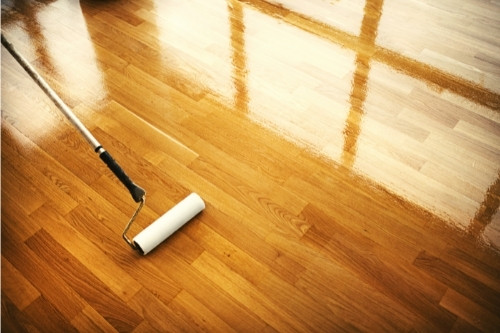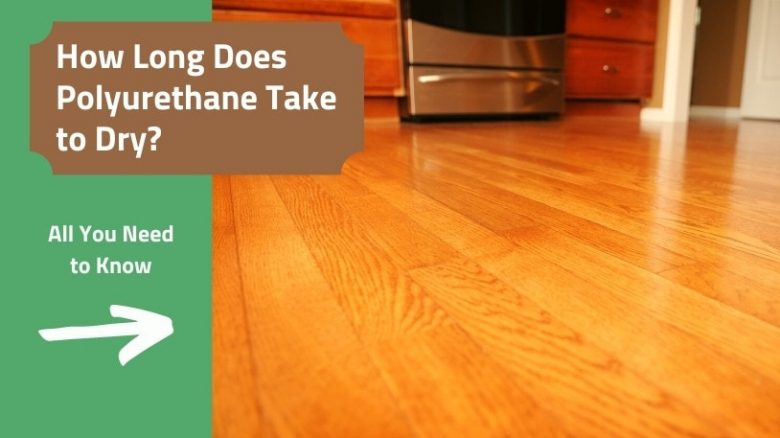Knowing how long it takes for polyurethane to dry is particularly important when using the product on a floor. Start using the room too early, and all the hard work of applying the finish is undone. While the answer to the drying time of polyurethane should be straightforward, there are a few variables to understand.
I remember many years ago renovating a house and using polyurethane to seal the floorboards I’d sanded. Being young and impatient, I walked on the floor in my socks once the floor felt dry. I took two steps before realizing the polyurethane had skinned but wasn’t fully dry, and I left furry footsteps, which required extensive repair once the floor had truly dried.
To prevent you from making my mistake, I’ll run you through everything you need to know before applying polyurethane to your project.
How long does polyurethane take to dry?
Water-based polyurethanes will accept light handling and a second coat 2 hours after application. The normal use of the surface can resume after 24 hours.
Oil-based polyurethanes take 3 to 4 hours before handling or recoating. Allow 48 hours before using the surface normally. However, read on for some important tips.
How long does oil-based polyurethane take to dry

The drying times for oil-based polyurethane assume applying thin coats in a location with good ventilation, an average air temperature of 77°, and a relative humidity of 50%. Thicker coats, lower temperatures, higher humidity, or a lack of air movement will extend the drying time.
Oil-based polyurethane may be recoated 3 to 4 hours following the previous coat. Some manufacturers advise not applying more than two coats within 24 hours. After applying the final coat, wait 24 hours before light use and handling. For floors, that means light foot traffic only.
Once 48 hours have elapsed since the final coat, you can replace furniture and rugs. While you can use the surface, proceed with caution, as the surface is not cured and can be marked by rough treatment. See our comments later in this article regarding curing times.
How long does water-based polyurethane take to dry

As with oil-based polyurethane, remember that drying times for water-based polyurethane are measured at 77° F and 50% relative humidity. Manufacturers also advise good ventilation. If it’s colder, damper, or in still air, expect the drying times to be longer.
Water-based polyurethane dries quickly, taking 2 hours before light handling and the application of a recoat is possible. Normal use can resume 24 hours after applying the final coat. Despite the 24-hour drying time, my advice is to treat the surface with caution. Rough handling or dropping furniture on the surface can damage the coating. Please read on to understand when the polyurethane will be cured and at its full strength.
Related: Oil vs Water-Based Polyurethane: Key Differences
How long does spray polyurethane take to dry

When you spray polyurethane, the coats will be much thinner than when applied with a brush. So, although the manufacturer will tell you to wait the same amount of time as when you’re brushing it on, I usually find the drying time for a sprayed finish is slightly faster. That’s 1.5 hours for water-based polyurethane and about 2.5 hours for an oil-based product.
How long does polyurethane take to cure?
Regardless of the type of polyurethane or the manufacturer, your polyurethane finish will take between 25 and 30 days to cure. After this time, the polyurethane coating will be inert, and no further chemical changes will occur.
Difference between drying and curing
To understand the difference between drying and curing, we need to understand how polyurethane is made and the chemical processes that occur once it is applied. The active constituent of polyurethane is a synthetic polymer, or in layman’s terms, a plastic resin. This plastic resin is held in suspension by a carrier liquid.
In water-based polyurethane, the carrier liquid consists of an acrylic or latex-based solution. In oil-based polyurethane, the carrier liquid is a mineral solvent. In each case, it allows the resins to be applied and assists them in leveling out into an even, smooth film.
Two processes occur when polyurethane dries. The carrier liquid immediately begins to evaporate, which is the strong smell you get from freshly applied polyurethane. This evaporation takes a few hours, depending on the temperature and humidity.
The remaining synthetic polymer film is now exposed to air. A second process is called cross-linking. Cross-linking is the hardening of the resin from a chemical reaction with oxygen in the atmosphere.
While the resin may harden sufficiently for light use, the cross-linking process takes many days to complete. When the cross-linking reaction has been completed, the resin has reached its full mechanical strength and hardness. This state is described as being cured.
In summary, polyurethane is dry enough to recoat once most of the carrier liquid has evaporated and the cross-linking has started. The surface becomes usable and suitable for light traffic once the cross-linking has progressed to make the film hard enough to withstand handling. The film is cured once the cross-linking process is complete and the polyurethane resin is at its maximum hardness.
What affects polyurethane drying time
The drying time of polyurethane is affected by air temperature, relative humidity, and the amount of air movement around the surface. The thickness of the coats you apply will also have an impact. Manufacturers will state drying times that assume a temperature of 77° F at 50% relative humidity. If the air is cooler or moist, or the air in your room is still, expect drying times to take longer.
How to make polyurethane dry faster

If you’ve read the earlier paragraph on the difference between drying and curing, you’ll better understand this discussion on speeding up the drying time of polyurethane.
You can decrease the drying time of polyurethane by applying thin coats in higher temperatures at lower humidity while using good ventilation. However, it’s worth mentioning that what you’re speeding up is largely the evaporation of the carrier liquid. The cross-linking process of the resin is less affected by temperature.
Raising the temperature in the room with a heater, lowering the humidity with a dehumidifier, and allowing good airflow will take an hour or two off the usual drying time. However, the cure will still take three to four weeks.
Related: How to Apply Polyurethane to Wood (Step-by-Step)
What to do if polyurethane won’t dry
Be aware that the drying times given by the manufacturer assume a standard temperature and humidity and the application of thin coats. If your climate is colder or damper than the standard, or you’ve layered up many thick coats, the polyurethane will take a lot longer to dry. If you’ve tried raising the temperature or you’ve left the surface to dry for several days or a week, and the polyurethane still isn’t drying, there are only four possible reasons.
- Your polyurethane is in some way defective.
- You didn’t stir the tin.
- You applied a hardening oil to the wood, but you didn’t allow sufficient time for it to harden.
- The oils in the wood you’ve applied the coating to are stopping the cross-linking process.
If you’ve left the coating for a week or more and it’s still not drying, you have no option but to start again. You’ll need to use a paint stripper to remove the polyurethane from the surface and begin the application process from the beginning.
Once you’ve removed the sticky polyurethane, stir the can of polyurethane well and paint a single coat on a piece of cardboard to see if it dries. If it does, you know the polyurethane is fine. In that case, it’s likely the wood or its coating that’s causing you a problem.
If you had applied a hardening oil such as tung or linseed oil to the wood before using the polyurethane, you must ensure you allowed it sufficient time to harden off completely. Check the manufacturer’s instructions for guidance on the oil drying times. Once the oil has hardened off, you can reapply the polyurethane.
Many exotic woods contain natural oils that can contaminate polyurethane and interfere with the cross-linking process. I suggest wiping the wood down with mineral spirit to remove excess oil before applying a thin coat of shellac. The shellac seals the oils into the timber. Once the shellac is dry, you can apply the polyurethane without difficulty.
Related: How to Fix Polyurethane Mistakes (Expert Tips)
Table of drying & curing times for popular polyurethanes
| Product | Base | Touch | Recoat | Normal Use |
|---|---|---|---|---|
| MinWax Fast Drying | Oil | 2-3 Hours | 3-4 Hours | 24 Hours |
| Total Boat Marine Spar Varnish | Oil | – | 1 Hour | 48 Hours |
| MinWax One Coat | Water | 1 Hour | 2 Hours | 24 Hours |
| Rust-Oleum Ultimate | Water | 1 Hour | 2 Hours* | 48 Hours |
| General Finishes High Performance | Water | 1 Hour | 2 Hours | 24 Hours |
| Varathane Ultimate Polyurethane | Water | 30 mins | 2 Hours | 24 hours |
* Do not apply more than 2 coats within a 24-hour period
FAQs
How long does it take for polyurethane to dry on hardwood floors?
Between 24 and 48 hours, depending on the type of polyurethane you’ve used. Follow the manufacturer’s guidance printed on the tin.
When can you walk on polyurethane wood floors?
Allow 24 hours before walking on the floor. If the polyurethane is oil-based, allow light foot traffic only for the next 24-hour period, as oil-based polyurethane takes longer to dry.
When can you put furniture on polyurethane floors?
I suggest not placing furniture or rugs on the newly coated floor for 48 hours. While water-based polyurethanes dry more quickly than oil-based, the coating is still curing, quite soft, and easily damaged.
How long does polyurethane take to dry on wood furniture?
Your furniture will be dry enough for light handling after 2 to 4 hours. Allow 24 hours before subjecting it to normal use.
How long does fast-drying polyurethane take to dry?
Most fast-drying polyurethane is dry enough for light foot traffic after 12 to 18 hours, but check the manufacturer’s guidance on the tin.
How long to let polyurethane dry between coats?
Allow 2 hours for water-based polyurethane and 3 to 4 hours for oil-based products.
Related: How Many Coats of Polyurethane to Apply
How long for polyurethane to dry – conclusion
Many variables affect the drying time of polyurethane, not least the thickness of the coat you apply and the temperature at which you apply it. If I have one last piece of advice, it’s to be patient. You put so much work into preparing and applying the polyurethane; trying to save an hour or two by hastening the process might see you starting again. That old adage applies here: “There’s never time to do it properly, but there’s always time to do it twice.” I hope the information has helped. Good luck with your project.

